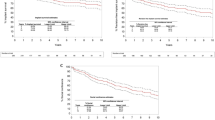Abstract
PURPOSE: This study was undertaken to evaluate a single-institution experience with the Acticon® artificial bowel sphincter for the treatment of intractable fecal incontinence. METHODS: At the University of Minnesota, 45 consecutive patients underwent artificial bowel sphincter placement (Group I, 1989–1992, n = 10; Group II, 1997–2001, n = 35). Group I was reviewed retrospectively and Group II prospectively. RESULTS: The outcome for Group I patients was initially reported in 1995 (mean age, 32; range, 15–52 years; 7 males). Of these 10 patients, 4 required explantation (2 required stomas), and 6 have a functional artificial bowel sphincter; 2 patients had devices successfully replaced for fluid leaks (at 6 and 10 years). In Group II, artificial bowel sphincter placement was attempted in 37 patients and was successful in 35 (mean age, 47; range, 18–72 years; 11 males). A total of 14 patients required explantation, 12 (34 percent) for infection and 2 (6 percent) for pain. In total, 13 patients have required 21 revisions, including 7 complete device replacements. The infection rate for revisions was 19 percent; four patients required explantation after revisions. Of 18 patients whose artificial bowel sphincter failed, 9 required a stoma. In all, 17 (49 percent) patients have a functional artificial bowel sphincter. In Group II fecal incontinence severity scores decreased from a mean of 103 preimplant to 59 at one year and to 23 at two or more years (P < 0.001) in patients who retained their devices. Quality of life scores improved in all patients at six months and at one year (P < 0.01). CONCLUSION: Artificial bowel sphincter therapy leads to long-term improved continence and quality of life in patients whose implantation is successful. Success rates have not improved in the two patient groups, with infection remaining a major challenge. However, once successfully established, artificial bowel sphincter function remains stable for many years.
Similar content being viewed by others
References
JF Johanson J Lafferty (1996) ArticleTitleEpidemiology of fecal incontinence Am J Gastroenterol 91 33–36
R Nelson S Furner V Jesudason (1998) ArticleTitleFecal incontinence in Wisconsin nursing homes Dis Colon Rectum 41 1226–1229
MJ Borrie HA Davidson (1992) ArticleTitleIncontinence in institutions CMAJ 147 322–328
J Christiansen M Lorentzen (1987) ArticleTitleImplantation of artificial sphincter for anal incontinence Lancet 2 244–245
PA Lehur P Glemain S Bruley des Varannes JM Buzelin J Leborgne (1998) ArticleTitleOutcome of patients with an implanted artificial anal sphincter for severe faecal incontinence. A single institution report Int J Colorectal Dis 13 88–92
DF Altomare G Dodi F La Torre G Romano E Melega M Rinaldi (2001) ArticleTitleMulticentre retrospective analysis of the outcome of artificial anal sphincter implantation for severe faecal incontinence Br J Surg 88 1481–1486
PE O’Brien S Skinner (2000) ArticleTitleRestoring control Dis Colon Rectum 43 1213–1216
J Christiansen OO Rasmussen K Lindorff-Larsen (1999) ArticleTitleLong-term results of artificial anal sphincter implantation for severe anal incontinence Ann Surg 230 45–48
WD Wong LL Jensen DC Bartolo DA Rothenberger (1996) ArticleTitleArtificial anal sphincter Dis Colon Rectum 39 1345–1351
PA Lehur JV Roig M Duinslaeger (2000) ArticleTitleArtificial anal sphincter Dis Colon Rectum 43 1100–1106
C Baeten F Spaans A Fluks (1988) ArticleTitleAn implanted neuromuscular stimulator for fecal continence following previously implanted gracilis muscle Dis Colon Rectum 31 134–137
GM Baeten BP Geerdes EM Adang et al. (1995) ArticleTitleAnal dynamic graciloplasty in the treatment of intractable fecal incontinence N Engl J Med 332 1600–1605
RD Madoff HR Rosen CG Baeten et al. (1999) ArticleTitleSafety and efficacy of dynamic muscle plasty for anal incontinence Gastroenterology 116 549–556
CG Baeten HR Bailey A Bakka et al. (2000) ArticleTitleSafety and efficacy of dynamic graciloplasty for fecal incontinence: report of a prospective, multicenter trial. Dynamic Graciloplasty Therapy Study Group Dis Colon Rectum 43 743–751
WD Wong SM Congliosi MP Spencer et al. (2002) ArticleTitleThe safety and efficacy of the artificial bowel sphincter for fecal incontinence Dis Colon Rectum 45 1139–1153
KE Matzel U Stadelmaier M Hohenfellner FP Gall (1995) ArticleTitleElectrical stimulation of sacral spinal nerves for treatment of faecal incontinence Lancet 346 1124–1127
KE Matzel U Stadelmaier M Hohenfellner W Hohenberger (2001) ArticleTitleChronic sacral spinal nerve stimulation for fecal incontinence Dis Colon Rectum 44 59–66
E Ganio A Masin C Ratto et al. (2001) ArticleTitleShort-term sacral nerve stimulation for functional anorectal and urinary disturbances: results in 40 patients. Evaluation of a new option for anorectal functional disorders Dis Colon Rectum 44 1261–1267
HR Rosen C Urbarz B Holzer G Novi R Schiessel (2001) ArticleTitleSacral nerve stimulation as a treatment for fecal incontinence Gastroenterology 121 536–541
AJ Malouf CJ Vaizey RJ Nicholls MA Kamm (2000) ArticleTitlePermanent sacral nerve stimulation for fecal incontinence Ann Surg 232 143–148
E Ganio C Ratto A Masin et al. (2001) ArticleTitleNeuromodulation for fecal incontinence: outcome in 16 patients with definitive implant. The initial Italian Sacral Neurostimulation Group (GINS) experience Dis Colon Rectum 44 965–970
TH Rockwood JM Church JW Fleshman et al. (2000) ArticleTitleFecal Incontinence Quality of Life Scale Dis Colon Rectum 43 9–17
Author information
Authors and Affiliations
About this article
Cite this article
Parker, S.C., Spencer, M.P., Madoff, R.D. et al. Artificial Bowel Sphincter. Dis Colon Rectum 46, 722–729 (2003). https://doi.org/10.1007/s10350-004-6647-5
Issue Date:
DOI: https://doi.org/10.1007/s10350-004-6647-5




